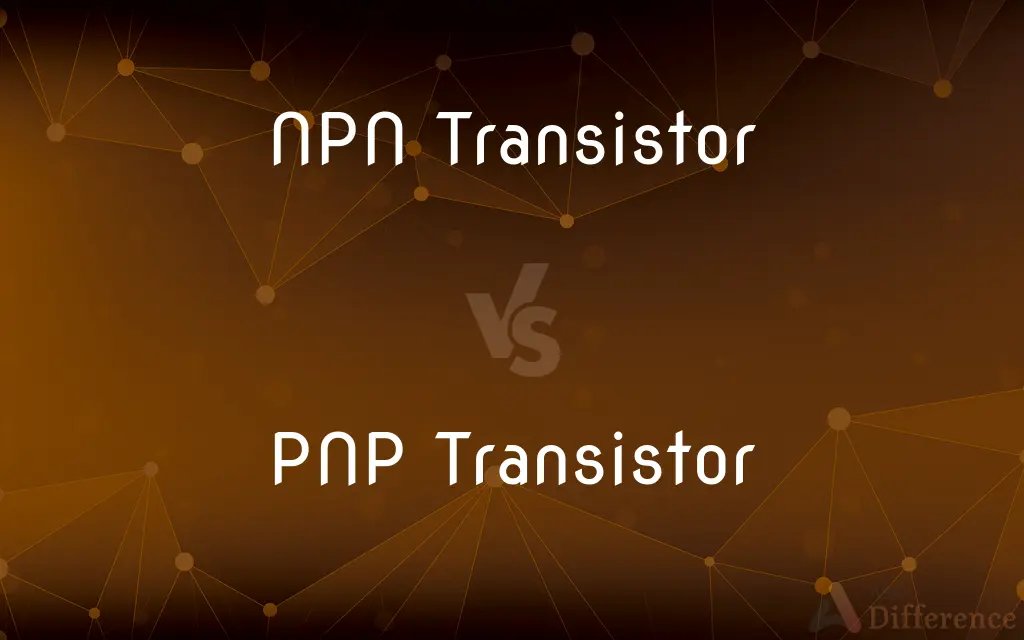NPN Transistor vs. PNP Transistor — What's the Difference?
By Tayyaba Rehman — Published on January 11, 2024
NPN transistors have one P-type material sandwiched between two N-type materials, using electrons as majority carriers, while PNP transistors consist of one N-type material between two P-type materials, using holes as majority carriers.

Difference Between NPN Transistor and PNP Transistor
Table of Contents
ADVERTISEMENT
Key Differences
NPN transistors consist of two N-type semiconductor materials separated by a thin layer of P-type material. Conversely, PNP transistors have two P-type materials separated by an N-type material.
In NPN transistors, the flow of electrons from the emitter to collector forms the current, and a positive voltage is applied to the collector. In PNP transistors, the current flows from the collector to the emitter with holes as charge carriers, and the collector is typically connected to a negative voltage.
NPN transistors are generally more efficient than PNP transistors in terms of electron mobility, making them more common in electronic circuits. PNP transistors, while less common, are used when a positive voltage needs to be controlled by a switch.
The base-emitter junction in an NPN transistor must be forward-biased for it to conduct, whereas in a PNP transistor, the base-emitter junction is reverse-biased under normal operating conditions.
NPN transistors are often used in high-speed switching applications due to their faster response with electron flow. PNP transistors are used in applications where complementarity with NPN transistors is needed.
ADVERTISEMENT
Comparison Chart
Semiconductor Materials
One P-type between two N-type materials.
One N-type between two P-type materials.
Charge Carriers
Electrons are the majority carriers.
Holes are the majority carriers.
Current Direction
Flows from the emitter to collector.
Flows from the collector to emitter.
Voltage Polarity
Positive voltage at the collector.
Negative voltage at the collector.
Common Applications
Preferred in high-speed switching circuits.
Used where a positive voltage control is needed.
Compare with Definitions
NPN Transistor
Current in an NPN transistor flows from the emitter to the collector.
We designed the circuit with an NPN transistor to facilitate the current flow direction.
PNP Transistor
In PNP transistors, current flows from the collector to the emitter.
The current flow in the PNP transistor was reversed compared to the NPN type in the circuit.
NPN Transistor
NPN transistors are commonly used in digital switching applications.
The microcontroller’s output was connected to an NPN transistor for controlling the LED.
PNP Transistor
The base-emitter junction of a PNP transistor is typically reverse-biased.
We reverse-biased the PNP transistor’s base-emitter junction to initiate conduction.
NPN Transistor
NPN transistors require the base-emitter junction to be forward-biased.
To activate the NPN transistor, we applied a positive voltage to its base.
PNP Transistor
PNP transistors primarily use holes as their charge carriers.
The PNP transistor operated by facilitating the flow of holes from its emitter to collector.
NPN Transistor
NPN transistors use electrons as their primary charge carriers.
The NPN transistor in the circuit switched rapidly due to the high mobility of electrons.
PNP Transistor
A PNP transistor is a semiconductor device with one N-type layer between two P-type layers.
In the voltage regulator circuit, we used a PNP transistor for controlling the output.
NPN Transistor
An NPN transistor is a semiconductor device with one P-type layer between two N-type layers.
In the amplifier circuit, the NPN transistor was used to boost the signal.
PNP Transistor
PNP transistors are used for controlling positive voltages in a circuit.
To switch the positive supply line, a PNP transistor was the preferred choice.
Common Curiosities
Is the base of an NPN transistor positive or negative?
The base of an NPN transistor is positive relative to the emitter.
In which applications are PNP transistors preferred?
PNP transistors are preferred in applications requiring control of positive voltages.
Which is more commonly used, NPN or PNP transistors?
NPN transistors are more commonly used due to their higher electron mobility.
What is the main advantage of using NPN transistors?
The main advantage is their efficiency and suitability for high-speed switching.
How do you identify an NPN transistor?
An NPN transistor can be identified by checking its datasheet or using a multimeter.
Can NPN and PNP transistors be used interchangeably?
They cannot be used interchangeably due to their different operating characteristics.
Can NPN and PNP transistors be used together?
Yes, they are often used together in complementary or push-pull amplifier circuits.
What happens if you reverse the connections on an NPN transistor?
Reversing the connections can prevent the transistor from operating or damage it.
Do PNP transistors require more power than NPN transistors?
No, the power requirement depends more on the circuit design than the type of transistor.
Can a PNP transistor be used as a switch?
Yes, PNP transistors can be used as switches in circuits.
Are there any specific safety precautions for using PNP transistors?
Standard precautions for handling semiconductors apply, such as avoiding static discharge.
What determines the conductivity of a PNP transistor?
The conductivity is determined by the current flowing through the base-emitter junction.
Are NPN transistors used in digital circuits?
Yes, NPN transistors are widely used in digital circuits for switching purposes.
How is the base current of an NPN transistor controlled?
The base current is controlled by applying a voltage to the base relative to the emitter.
Are PNP transistors good for power amplification?
Yes, PNP transistors can be used effectively in power amplification circuits.
Share Your Discovery

Previous Comparison
miRNA vs. siRNA
Next Comparison
Liverworts vs. MossesAuthor Spotlight
Written by
Tayyaba RehmanTayyaba Rehman is a distinguished writer, currently serving as a primary contributor to askdifference.com. As a researcher in semantics and etymology, Tayyaba's passion for the complexity of languages and their distinctions has found a perfect home on the platform. Tayyaba delves into the intricacies of language, distinguishing between commonly confused words and phrases, thereby providing clarity for readers worldwide.












































